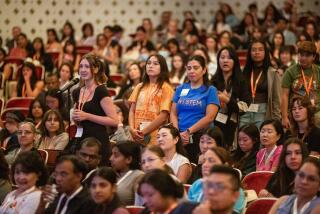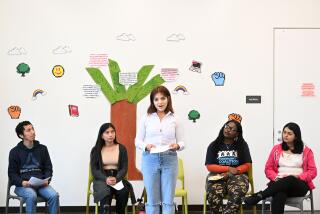Future Scientist : Teen-Ager Gets Head Start in Biotechnology by Landing Job at Amgen
- Share via
Most of Lucy Vega’s friends would be surprised to hear why she quit her part-time job at a fast-food restaurant.
The Oxnard High School senior has not talked a lot about her new job, chiefly because it is so hard to explain.
Three times a week, the energetic 18-year-old drives over the Conejo Grade to the Thousand Oaks headquarters of Amgen--the largest biotechnology firm in the world--where she dons a lab coat and sets to work in the X-ray crystallography lab.
Amgen officials call Vega a symbol of the future in the field of science--a field often criticized for shutting out girls long before they reach their upper teens.
Vega’s family says she is a symbol of the dream they envisioned when they came to the United States in 1982: She will soon be the first in her family to go to college.
Little of this is lost on Vega herself, although she sees it in less grandiose terms. “I decided I liked science and, when the chance to work here came up, I decided to go for it,” she said. “I had nothing to lose.”
Until last year, Vega, like most high school students, had never heard of Amgen and knew nothing about biotechnology--a complex scientific field that uses advanced cellular and molecular biology to create treatments for a variety of ailments.
But an assignment in her 11th-grade English class changed that, and Vega got her first glimpse at the world of science.
“I was supposed to shadow somebody who worked in a job that interested me,” she recalled. “One of my teachers suggested Amgen. When I saw the labs and heard about what they were doing, it just seemed extremely interesting to me.”
Vega spent the day with Tim Osslund, a research scientist who has worked at Amgen since it was founded in Thousand Oaks in 1980. They toured the company’s maze of research laboratories, which have sprouted up across 100 acres of land in Newbury Park since Amgen products found worldwide success in the 1980s.
As Vega got set to leave, Osslund said it struck him that one day was not sufficient to truly appreciate the experience of working in a lab.
“It dawned on me that we could really give high school kids an idea of how science works,” Osslund recalled. “I also realized that it’s rare for an industrial scientist to have the chance to give something back.”
Osslund hired her to work as his lab assistant in one of the company’s newest and most advanced laboratories.
When Vega arrived for her first day of work in October, she said she was so nervous, she was afraid to touch anything.
“I had never seen things like this before,” Vega said last week, pointing to a counter filled with test tubes and complex equipment used in X-ray crystallography. “I kept thinking, ‘Oh my God, what if I do this wrong? I’ll ruin everything.’ ”
Osslund was jittery as well.
“The joke was that she would come into the lab and spontaneously combust,” Osslund said. “It’s not that this work is very dangerous, but it is a serious lab. For the first month, I told her not to wander around, not to touch things. We watched her like a hawk.”
Vega’s meticulous work quickly impressed Osslund, who increasingly began to see the potential of bringing a high school student into the lab. Every few weeks, Osslund would sit down with her and explain the projects and their goals.
As important as being in the lab and doing the work, Osslund said, was understanding why the work was being done.
X-ray crystallography, Vega can now explain, involves getting three-dimensional molecular structures from genetic material. The process, she says, could lead to treatments for a host of illnesses, including Alzheimer’s disease.
She said she is so excited by the work that she plans to make a career in crystallography.
“I think there’s so much that you can do to help people through science,” Vega said. “I’m going to go to college for as long as it takes for me to get a job here.”
Recently, Vega was accepted at UC Davis, which Osslund said is well known for its science departments.
When she broke the news to her mother that she would be leaving for Davis, which is just west of Sacramento, the reaction was mixed.
“When I first heard she would be leaving our home, I was nervous. But when I thought about her going to a university, I felt very happy and very proud,” Magdalena Vega said. “There are not words to describe how I feel.”
Vega, her mother said, has helped the whole family survive difficult times since they moved from Mexico to Oxnard. Magdalena and Carlos Vega have worked several jobs since being laid off by an Oxnard grower three years ago.
The family has frequently had trouble paying rent and keeping food in the cupboards. But Magdalena Vega said all of the hard times will be forgotten if Lucy and her other two children can fulfill their dreams.
“That’s why we moved here,” she said. “The whole reason was so the children could have a better life and so they wouldn’t have to work as hard as we have.”
And Lucy Vega, she said, has always had a natural gift for her studies.
“Even when she was very young, she would always be independent,” she said. “She would go off and study when others were watching television.”
Vega’s interest in science was unfailing, even as she entered high school--a time, some local educators say, by which girls have already been pushed away from science and math.
“There are numerous studies which have found that girls are no longer encouraged to stick with those fields when they enter intermediate school,” said Therese Hughes, who organizes an annual workshop in Thousand Oaks encouraging girls to pursue careers in science and math.
“When girls enter a science class, they still get a reaction like, ‘Oh, what are you doing here?’ ” Hughes said.
That factor did not escape Osslund when he was considering hiring Vega.
“One of the problems with science has always been that when children turn 8 or 9 years old, they get turned off,” Osslund said. “Science goes from being neat to being yucky--especially for little girls.”
Vega said she does not recall if she was discouraged from going into science, but that if she was, it didn’t work.
“I have always liked it,” she said. “I’m very excited about making it my career.”
Osslund, who has become a sort of mentor for Vega, gushes when he talks about her future.
“I want her to go all the way,” he said. “The Ph.D., the career, everything.”
When Vega leaves in August to start working toward that career, Osslund said he will begin searching for another high school student to take under his wing.
“There are a lot of 18-year-olds who couldn’t handle this job,” he said. “But having her here has shown that this can be very valuable. Lucy has proven a lot.”






